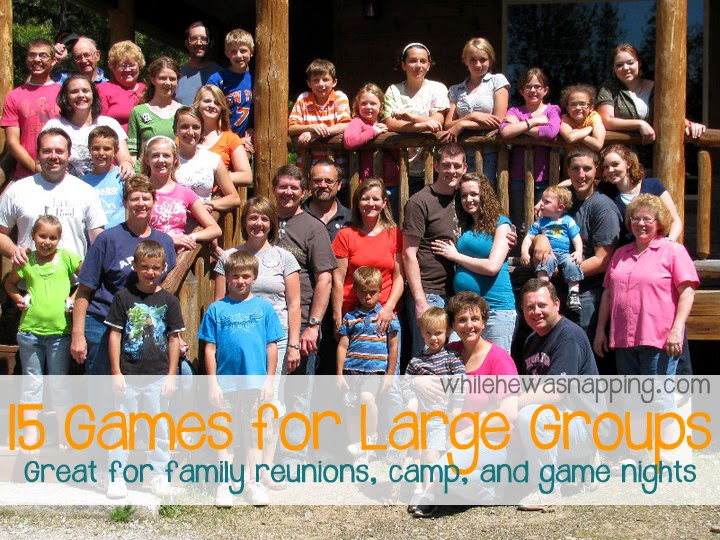My dad’s siblings rotate who plans their family reunion each year. My poor aunt and uncle have actually planned four reunions in the last two years due to some unexpected and unfortunately timed occurrences that required a lot of adjustment to plans already in place.
However, they have been super awesome and haven’t complained, at least not to me. Haha. The latest schedule of events had my brother, a cousin and myself planning a family game night. Now, Mr Napping and I enjoy a good game night. But, not many of those include nearly 50 participants, ranging in age from mere months to eight decades. How do you entertain that many people with such differing interests, abilities and attention spans?!?
So, I dusted off my thinking cap and brushed the cobwebs from my brain and tried to think of games that lots of people with different abilities and attention spans could play. Our portion of the night doesn’t start until around 8pm, so we won’t have a lot of daylight. We opted for a photo scavenger hunt (we’re conning people into taking and sharing photos at this reunion… mwawawah) and Pictionary. Hello cheap games that new families can afford to host. But, I’ve come up with some other ideas too.
– Photo Scavenger Hunt. We are having people use their cell phones. I have made up a list of items to find. Because we want photos of people, and not just objects, the items specify people or groups of people to include in the photos. For example: “A father and daughter”, “Two generations” “A grandparent/grandchild set” and the like. We have set up an email account that photos can be sent to for submission. We decided to have each person be their own team and award points individually. One point goes to each person in the photo as well as a point to the photographer (whoever submitted the photo). The person with the most points is the winner.
– Pictionary. You know how this works, right? There are strips of paper with people, places, or things written on them. Divide into two teams. Teams take turns choosing an artist to draw what is on the strip of paper they choose. Their team then tries to guess what they are drawing. We are doing this on a window with window markers. Easy clean up and we don’t have to worry about a ton of paper.
– Water Balloon Volleyball. Divide into even teams and give each pair a towel. Each person holds one end of the towel. Typically about 8 players, 4 sets are on each team (16 total players in each game). A water balloon is then placed in one of the towels and the pair holding that towel flings the water balloon to the other team, who then try to catch the balloon in one of their towels. The team who lets the balloon pop awards the other team a point and the net serve. A net is optional to divide the teams, although a line on the ground works too.
– Pass the Water. This game is pretty easy and something that is suitable for a lot of age ranges. It’s also an active game so the wiggle worms should be happy too. You will need a large bucket full of water and smaller buckets for each team. Each participant gets a cup. Divide into equal teams. Each team stands in a line with everyone facing the bucket full of water. On the “GO” signal, the person at the front of each line runs up, fills their cup, runs back to their line and faces the bucket of water again. Then each team races to fill the bucket at the end of their line. The catch is that the water must be passed from cup to cup over the head.
– Charades. Similar to Pictionary, but act out the topic on the slip of paper instead of drawing it. No talking!
– Human Knot. Stand in a circle and each person grabs the hand of someone across the circle. The circle then has to untangle itself by stepping over, under and untwisting the knotted hands.. The key is that every one grabs two different people’s hands and not the hands of someone they are standing next to.
– Kick the Can. One (or more) person is “it” and they are trying to protect the ‘can’. You can use an actual can or another object. “It” tries to tag the other players to get them out of the game, while the other players try to kick the can. If the can gets kicked everyone else wins the game. If “it” tags everyone or successfully guards the can for ten minutes, they win.
– Touch Football. The basic rules of American football without the physical contact. Tackles are made with a touch (one or two hands, decided before play begins).
– Capture the Flag. Divide players into two teams. Each team has a “flag” that they hide. The flag can be anything really, as long as the other team knows what it looks like. Teams hide their flag and then try to locate and capture the other teams flag. Players are eliminated from the game if they are tagged by any player of the opposing team. The first team to capture the other’s flag wins. Night alternative: Glow sticks for an increase in the difficulty level.
– Balloon Stomp. Divide into equal teams. Each team gets the same number of pre-filled balloons (your choice of water or air). The objective is to pop the other team’s balloons while keeping your team’s balloons intact. The last team with balloons wins.
– Simon Says. Players line up and one person gets to be “Simon”. “Simon” gives the other players directives (jump three times, clap your hands, hop on one foot) beginning with “Simon Says”. If Simon leaves off the “Simon Says” of the directive, players don’t complete the action. Any that do are eliminated. The last player wins.
– Dodge Ball. Basic baseball rules, but you use a large rubber ball instead. Players are divided into two teams. One team plays the field while the other runs the bases. One at a time, players from the running team are “pitched” the rubber ball by rolling it on the ground. The runner then kicks the ball and runs around the bases, like in baseball. Tagging the player or catching the ball before it hits the ground is an out. The running team gets three outs and then the teams switch positions. Game play can last as long as you want.
– Last Man Standing. This is a more active, less inebriated version of “I never”. Each person sits in a chair in a circle with one person standing. The person standing up says “I’ve never…” and then fills in the blank. If you have done whatever the stander says you have to move seats. You can’t move to your immediate left or right. The stander tries to get a seat while everyone is moving. Whoever is left without a chair starts a new round by stating their “I never…” statement.
– Ninja. Players stand in a circle. One at a time, each player makes a single move and tries to touch the player to their right. If the touch connects to the target, the target is eliminated from the game. If not, they get a single move to touch the person to their right. After players make their single move, they are frozen. Any movement disqualifies the player. The winner is the last player standing. This is a fast-paced game and good for older kids.
– Sardines. Like Hide & Go Seek in reverse. One person is “it”. “It” goes and hides while the remaining players count to a specified number with their eyes closed. Players then go hunting for “it”. When they find “it”, they hide with them as quietly and compactly as possible. The group gets larger and harder to hide as more players find “it”. The objective is to not be the last one to find “it”.







